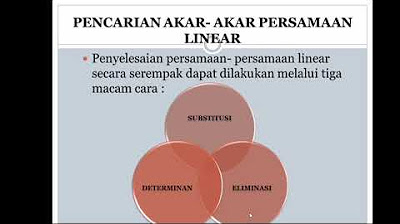Bisection Method | Numerical Methods
Summary
TLDRIn this video, the bisection method is introduced as a technique for solving non-linear equations and finding the roots of functions. The process involves selecting two points with opposite signs, finding the midpoint, and iteratively narrowing the range until the root is located within an acceptable error. The method is simple but comes with limitations, such as challenges in choosing the correct initial interval and handling multiple roots. The video also hints at future practical demonstrations in Excel and programming languages to reinforce the concepts.
Takeaways
- 😀 The bisection method is a technique used to find the roots of a non-linear function, i.e., where the function crosses the x-axis.
- 😀 The method involves repeatedly narrowing down an interval that contains the root by evaluating the function at different points.
- 😀 Step 1: Define an initial interval [a, b] where the function values at a and b have opposite signs, confirming that a root exists within the interval.
- 😀 Step 2: Calculate the midpoint c of the interval, and evaluate the function at c. This helps determine whether the root lies to the left or right of c.
- 😀 If the product of the function outputs at a and c is negative, the root lies to the right of c. If the product is positive, the root lies to the left of c.
- 😀 The process is repeated by updating the interval to either [a, c] or [c, b] based on the sign of the product of the outputs.
- 😀 The method continues until the interval becomes small enough to provide an acceptable level of error, which is measured by the difference between a and b.
- 😀 The bisection method is simple but has some limitations, such as difficulty in choosing the correct initial interval.
- 😀 If there are multiple roots within a single interval, the bisection method cannot distinguish between them and may converge to any one of them.
- 😀 The method guarantees convergence as long as the initial interval contains a root, and the function is continuous over that interval.
- 😀 In future videos, the method will be applied step-by-step using tools like Microsoft Excel and programming languages to reinforce understanding.
Q & A
What is the bisection method used for?
-The bisection method is used to solve non-linear equations and non-linear systems by finding the roots of a function, which are the points where the function crosses the x-axis.
What is the first step in the bisection method?
-The first step is to define a region with two x-values (a and b) where the root is believed to exist. The outputs of a and b must have opposite signs, ensuring that the function crosses the x-axis within this range.
How can you validate that the function crosses the x-axis between the two initial points?
-You can validate this by multiplying the outputs of the two points (a and b). If the product of the two outputs is negative, it indicates that one is positive and the other is negative, confirming that the function crosses the x-axis.
What happens in the second step of the bisection method?
-In the second step, you find the midpoint between the two initial points (a and b) by averaging their values. This midpoint, denoted as c, is then tested to see if the root lies to the left or right of it.
How do you determine which side of the midpoint contains the root?
-To determine which side contains the root, you calculate the product of the outputs of points a and c. If the product is negative, the root lies to the right of the midpoint. If the product is positive, the root lies to the left, and you repeat the process for the appropriate side.
How does the bisection method ensure convergence?
-The bisection method ensures convergence by continuously halving the search interval based on which side contains the root. This process is repeated until the interval becomes sufficiently small, indicating that the root has been found within an acceptable error margin.
What is the error in the bisection method and how is it measured?
-The error in the bisection method is the difference between the two values in the current range. As the interval shrinks, the error reduces, and the root is located more precisely within this region.
What are the drawbacks of the bisection method?
-Some drawbacks of the bisection method include the difficulty of selecting initial points if the root is not clearly within a defined range, and the method's inability to handle multiple roots in the same range, which could cause convergence to the wrong root.
Can the bisection method be used to solve any non-linear function?
-The bisection method can only be used to solve non-linear functions where an initial interval can be found with opposite signs at the endpoints. It may not work if the function does not change signs within the chosen interval.
What will the next video in the series cover?
-The next video will walk through solving a bisection method problem by hand, as well as demonstrate its implementation in Microsoft Excel and various programming languages.
Outlines

このセクションは有料ユーザー限定です。 アクセスするには、アップグレードをお願いします。
今すぐアップグレードMindmap

このセクションは有料ユーザー限定です。 アクセスするには、アップグレードをお願いします。
今すぐアップグレードKeywords

このセクションは有料ユーザー限定です。 アクセスするには、アップグレードをお願いします。
今すぐアップグレードHighlights

このセクションは有料ユーザー限定です。 アクセスするには、アップグレードをお願いします。
今すぐアップグレードTranscripts

このセクションは有料ユーザー限定です。 アクセスするには、アップグレードをお願いします。
今すぐアップグレード関連動画をさらに表示

8. METODE LELARAN TITIK TETAP - FIX POINT ITERATION - METODE NUMERIK

SOLVING SYSYEM OF NONLINEAR EQUATIONS || PRECALCULUS

Konsep Metode Bagi Dua (Bisection Method)

Zeros de funções Método Iterativo Linear

5 MTK EKO PENCARIAN AKAR AKAR PERS LINEAR

METODE NUMERIK P7 PART 1/2 | METODE NEWTON-RAPHSON UNTUK MENYELESAIKAN PERSAMAAN NON LINIER
5.0 / 5 (0 votes)
